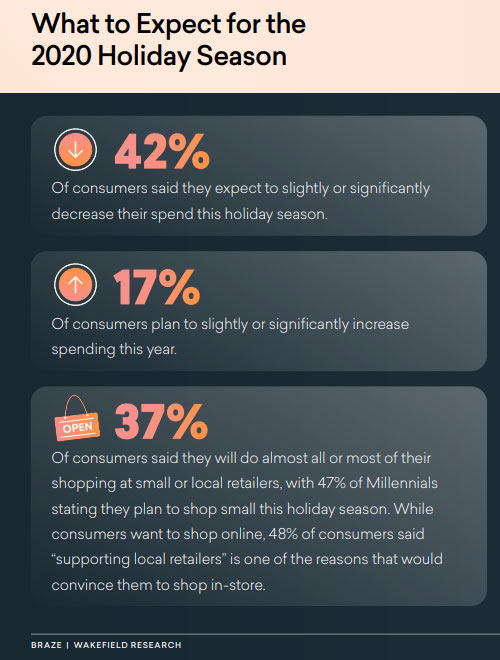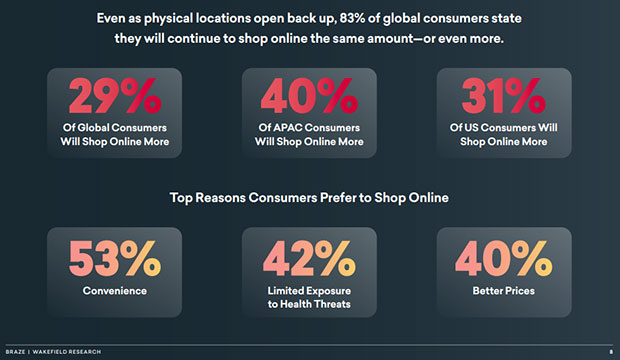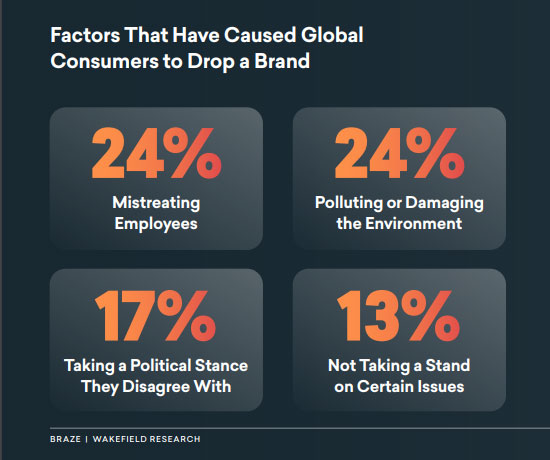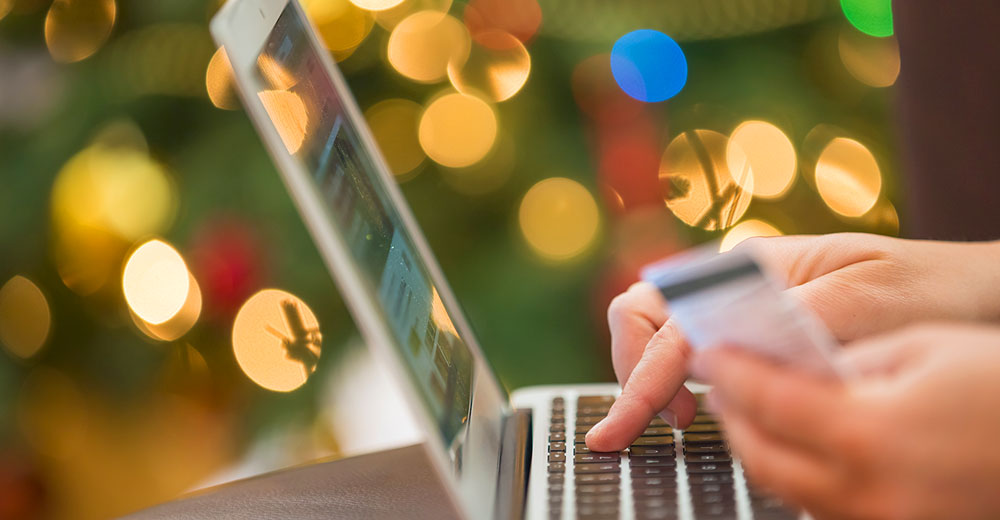The holiday shopping forecast and consumer spending patterns well into next year will be marked by a pullback in spending, an increase in consumer expectations for brand behavior, and a focus on supporting small businesses.
That prediction does not bode well for retailers and e-tailers alike. A report from customer engagement platform provider Braze suggests that marketers focus on brand values and trustworthiness to combat the continuing challenges retailers face in courting consumers across generations, each with distinct preferences, behavior, and expectations.
The Aug. 11 report titled “The Future of Retail: Opportunities for Brands in the New Normal” assesses COVID-19’s immediate and long-term impact on the retail industry.
Forty-two percent of the world’s shoppers said they expect to slightly or significantly decrease their spending. The Braze report sees the pandemic’s impact on retailers as a never-ending behavioral change where consumer shopping patterns are concerned.

“COVID-19 has changed the consumer retail experience forever as demand for e-commerce looks to become permanent, customer loyalty has been upended, and spending patterns have changed,” said Myles Kleeger, president and chief customer officer of Braze.
“To effectively serve customers and drive future growth, prioritizing customer engagement is more important now than ever. Brands that double down on digital and place personalization at the heart of their strategy will emerge from the pandemic stronger than before,” he said.
Customer Road Map
Marketers have a wide range of consumer reactions to consider.
Findings revealed that price matters to Gen Z, with 45 percent selecting it as a top factor when deciding on a retailer. Shopping locally is a big factor for other consumers.
Despite earlier reports about a rapid attraction to shop online, the Braze report shows that COVID-19 has also fueled support for small businesses, online or otherwise.
While consumers want to shop online, 48 percent said “supporting local retailers” is one of the reasons that would convince them to shop in-store. Inversely, less than a third of millennials (28 percent), Gen X (29 percent), and baby boomers (30 percent) said the same.
“The biggest takeaway from [our report] is that COVID-19’s impact is here to stay, and there’s actually a big opportunity now and during the holidays for customer acquisition,” Kleeger told the E-Commerce Times.
“For the most part, people will not be going back to their old ways,” he said, noting a conclusion from the study.
The report demonstrates this by showing that even as physical stores open back up, 83 percent of consumers intend to shop online the same amount or more.

Importance of Values
The research found that consumer buying decisions are no longer just about brand familiarity. Brand values and corporate empathy will play an increasing role in consumer loyalty and purchasing decisions.
A very low consumer response, only 10 percent, said “familiarity” was a top consideration when deciding where to shop. This is in contrast to 91 percent who responded that a company’s response to the pandemic, especially towards employees and customers, was an important criterion.
Companies that mistreat employees, contribute to pollution, or take opposing political stances were also revealed as reasons for consumers to shop elsewhere.

However, the way brands respond to COVID-19 has little impact on Gen Z and Gen X. Both age categories were least likely to let it impact their purchasing decisions.
Thirty-five percent of Gen Z and 34 percent of Gen X said that they were extremely or very likely to drop a brand based on their response to employees or customers during COVID-19, compared to 43 percent of millennials and 20 percent of boomers.
Retailers should be designing campaigns now to deepen relationships with customers in the months leading up to the holidays, according to the report. Building out effective onboarding and lifecycle marketing programs allows for lower overall acquisition costs while increasing the chances that customers are making purchases this holiday season and beyond.
Digital First With a Caution
The pandemic accelerated the move towards digital-first that was already in motion. That shift creates an opportunity for brands to tap markets they previously could not grab, said Kleeger.
Braze data shows that 26 percent of global consumers tried at least one new brand during the pandemic, and 95 percent of those intend to buy from one of these new brands again.
“That said, do not assume that once you have got them, those mobile shoppers are yours to keep. Our research shows that new customers acquired during COVID-19 are more likely to move on than those who signed up pre-pandemic,” Kleeger noted.
To improve retention, make sure that your marketing communication is useful, timely, and personalized to be relevant to each new shopper.
Competition for consumers’ attention and dollars will be fierce this fall, but well-crafted customer engagement programs that onboard new customers with care will reinforce new habits early and strengthen acquired shoppers’ bonds with your brand, so they are more likely to keep coming back, he explained.
Mobile Acquisition Tactics
The uptick in digital payments gives marketers new strategies. Merchants should focus on targeting consumers through mobile marketing campaigns, Kleeger advised.
“Since the start of the pandemic, users are increasingly on their phones, and Braze data shows that there was a 62 percent rise in mobile acquisition of new users for retail and e-commerce apps. This means that consumers are exploring brands and shopping through mobile, even when they are stuck at home,” he observed.
Mobile not only introduces new customers to new ideas and products. It also delivers on return. Mobile users acquired during the pandemic are 10 times more likely to make a purchase and 12 times more likely to make a second purchase.
“Diving into a mobile marketing strategy will help retailers expand their reach and convert more sales this year. For example, consumers who opted in to receive push notifications had more than four times higher 30-day retention rates than their counterparts who didn’t have push enabled,” Kleeger added.
New Need for Empathy
Kleeger suggested that marketers tune into consumer struggles in dealing with the pandemic. That, he said, is one of the biggest challenges, according to the report.
“It’s important to keep in mind that consumers are grappling with health risks and personal financial challenges, and empathy is key to any effective customer engagement,” he said.
More than a quarter of consumers say that a retailer’s response during COVID-19 will be a factor when deciding where to shop this holiday season. So brand humanity is more important than ever.
“Retailers can use this time to build brand awareness and community rather than focusing exclusively on sales,” he advised.
One way to do this is to focus on humanity by leveraging responsive messaging. The goal is to have digital notifications from a brand feel more like a conversation between two people.
“Braze research has found that using API-triggered and action-based messaging drives up to a five times increase in campaign conversion rates, even if these customers are not spending right now. Keeping consumers engaged will make them more likely to make a purchase in the future, and retail customers are 1.7 times as likely to make a purchase from brands that successfully demonstrate human communication,” said Kleeger.
Aim for a Broader View
As the pandemic continues, consumers will continue to grapple with concern over their health and economic well-being, according to Alex Fitzgerald, principal – consumer practice, at management consulting firm Kearney. Both suppress spending.
“Instead of trying to define the new normal, retailers should embrace a ‘no normal’ and develop analytics capabilities that allow them to take in market, consumer, and sales data and make real-time decisions across consumer experience (digital and physical), promotions, e-commerce fulfillment, and associate staffing,” he told the E-Commerce Times.
The challenge is that in these times of “no normal” holiday strategies of years past are not destined to do well, he said. At this point in the season, the assortment is largely set.
Retailers will need to focus on how to add flexibility and agility across their promotions schedule, e-commerce fulfillment, and staffing models in order to maximize their holiday performance, Fitzgerald explained.
“To do this, real-time analytics capabilities should be top of their must-have holiday list,” he said.
Personalization an Expectation
For retailers, consumer expectations are rising at the same time brand loyalty is falling, according to George Barker, head of marketing at Qubit. Personalization has become pervasive, with more than half of consumers now recognizing when an online shopping experience is tailored to them.
Two in three have an expectation that brands will personalize. This, coupled with the fact that more consumers are shopping on more websites, the place for differentiation is in relevant shopping experiences,” he told the E-Commerce Times.
If retailers do not focus on a unique customer’s in-session behavior or historical purchase history, then they will lose as a brand, especially with Black Friday and Christmas 2020 looming. The time for planning and mitigating those risks is now, he urged.
Research Methodology
Braze conducted research for “The Future of Retail: Opportunities for Brands in the New Normal” report using market research firm Wakefield Research.
Wakefield polled 8,000 globally representative adults ages 18+ across 10 markets: Australia, France, Germany, Indonesia, Malaysia, Singapore, South Korea, Thailand, the UK, and the U.S. The survey was conducted from July 3 to 13, 2020, using an email invitation and an online survey.
The report is based on several data sources and responses in addition to the consumer survey. Braze also aggregated its own customer data for the Future of Retail report.
























































Social Media
See all Social Media